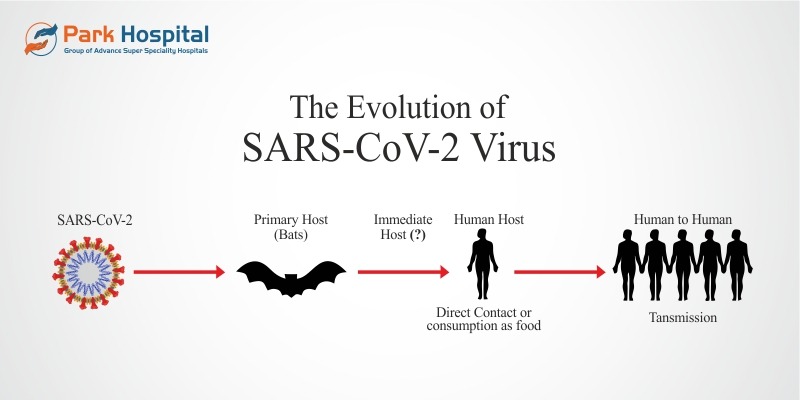The Evolution of SARS-CoV-2 Virus
There’s probably not a single person in the world who does not know about COVID-19. Some of us pay close attention to the latest news on the number of people infected around where we live. Questions about prevalence, safety, risk of infection, the severity of disease, future variations, etc run through everyone’s minds to varying degrees. But perhaps it's time to take a step back and look at the evolution of the SARS-CoV-2 virus objectively and in layman's terms to understand future implications for COVID-19 or any other new epidemics that seem possible in the world today.
SARS-CoV-2 Origin Story
SARS-CoV-2 is the virus that causes COVID-19. It is in the same family of viruses that cause the common cold or the more notorious Severe Acute Respiratory Syndrome (SARS) from 2003, and the Middle East Respiratory Syndrome of 2012. They have zoonotic origins - in fact, a key feature of SARS CoV 2 virus is its propensity to spread across boundaries of species. The SARS CoV 2 genome shows evidence of several recombination events to have taken place. This explains the formation of the spike protein that can attach itself to human and other mammalian cells. SARS-related coronaviruses are known to be found in bats. Many of them are also known to be able to infect humans.
What is a recombination event?
Coronaviruses are made of a long piece of RNA that is not capable of reassortment. However, when two coronaviruses infect the same cell, a new piece of RNA is pieced together from the parental RNA. This event is called a recombination.
Recombination plays an important role in the evolution of coronaviruses. In the case of SARS and MERS, nearly identical viruses were found in civets and camels respectively, clearly demonstrating zoonotic transmissions with intermediary hosts between bats and humans. However, non-human viruses nearly identical to the SARS-CoV-2 virus have yet to be found. But it is clear that a very complex journey of evolutionary recombinations and natural selection between coronaviruses from distinct host species and cross-species infections likely gave origin to the SARS-CoV-2 virus.
The continuing evolution of SARS-CoV-2 virus
Like SARS and MERS, the SARS-CoV-2 virus spreads from the droplets of the virus we breathe out, sneeze or cough into the air. Viruses need host cells to replicate and the coronavirus uses its spike proteins to attach itself to the host cell and fuse into its cell membrane to replicate.
In doing so, i.e., replication, rare errors take place. These ‘errors’ in the RNA copies of the virus are referred to as genetic mutation wherein a change takes place in the virus’s genetic code. In so far, the genetic evolution of the SARS-CoV-2 virus has been a relatively slow process as compared to an influenza virus. According to studies conducted, it is mutating approximately four times slower than the influenza virus. This can be attributed to its ability to proofread or auto-correct many errors that take place during replication.
One or more mutations in a viral genome cause a variant to be formed. As genetic changes take place, lineages start to emerge. A lineage is a group of viruses that can be tracked up to its parent variant.
The purpose of evolution
The singular purpose of the virus is to excel at spreading. For this, it needs to be contagious and it needs to somehow avoid being caught by the immune system. Variants like Delta and Omicron have been better at transmission than the strain from 2020. And it is just the tip of the iceberg with regards to the extent to what is possible for evolutionary variations.
This is especially significant for public health considerations. In the case of SARS-CoV-2, the original virus was taken to build a vaccine where 201 amino acids were used to help antibodies recognize the virus. In the Delta variant only two of these amino acids went through variations and thus had little to no impact on immunization from the virus. In the Omicron variant, 15 of these 201 amino acids were mutated and it helped the virus evade the immune system of those who were vaccinated or even previously infected. The possibility of mutation is much larger (while not infinite). Each amino acid can mutate in 19 different ways. Scientists have already documented hundreds of other mutations that the vaccines target.
What is clear from the Delta and Omicron variants is that they are from different lineages and there was a significant jump in mutations with the Omicron variant, which can happen again. The latest Arcturus variant is 1.2 times more contagious than Omicron. So one can expect waves of SARS-CoV-2 infections every year like the seasonal flu. The future will look at developing broader vaccines that are variant-proof and can fight novel coronaviruses.
The way evolution works is that it selects viruses and variants that are capable of spreading well. Whether one causes more severe a disease or not is only a subject of chance. Updating and improving vaccine efforts still remain the best defense against future waves or epidemics from coronaviruses.
Conclusion
The SARS-CoV-2 virus will continue to evolve and one can expect waves of infections every year like the seasonal flu. Scientists continue to keep a close eye on the virus and broader variant-proof vaccines will help fight novel coronaviruses. It is not too far-fetched to expect another epidemic-like event taking place. But we also expect that the world is a lot more ready today to fight such an event than it was before the SARS-CoV-2 virus.








